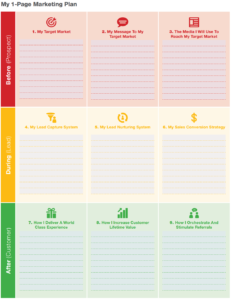If you’re running a business, you understand that a marketing plan is essential. What’s the point of having a fantastic product or service if no one even knows it exists! Right?
When I worked with big agencies and corporations, marketing plans were full of everything from branding blueprints to intricate social media strategies and sales roadmaps.
Don’t get me wrong, a detailed plan has its place. It would help if you covered the whole marketing mix—the product, price, place, and promotion.
However, a one-page marketing plan is your best bet for everyday business life.
Imagine having a mini-plan that tells you exactly what you need to do today to make your business grow? You can!
A one-page marketing plan is your quick go-to guide for daily action.
Let me explain in a little more detail:
What Is A One-Page Marketing Plan?
A one-page marketing plan summarises all the essentials needed to attract, nurture and retain new prospects for your business.
The genius thing about a one-page marketing plan is you can take it with you everywhere – pin it to the wall, save it as a screensaver or even carry it around in your pocket. Whatever makes your life easier!
There are three simple sections to a one-page marketing plan, each with its distinct stages. This isn’t rocket science; it’s about cutting to the chase and focusing on what you actually need to do.
The rule of thumb is if it doesn’t fit on one page, you’re making it too complicated.
If you’ve got a sales team, this should be their new marketing bible. It’s like a cheat sheet for success!
In fact, if you need help with your one-page marketing plan, join me on Friday, 3rd November, at the Holiday Inn in Bexley for my all-day Marketing Masterclass for marketing tips to skyrocket your profits.
In the meantime, here’s a breakdown of the simple steps:
Step 1: The Research Stage (Before)
This step is all about before you even start marketing to potential leads. It’s the most essential stage as it helps you understand who you should be marketing to, what you should say, and through what channels.
There are three questions you need to ask yourself in this section:
Who Is My Target Market?
Defining your target audience is vital to marketing (and business) success. Here are some handy tips for zeroing in on your ideal customers:
Identify Customer Pain Points: What problems does your product or service solve? Knowing this can help you understand who would benefit most from your offerings.
Analyse Your Current Customer Base: Look at the people already buying from you. What do they have in common? Chances are, others like them could be your target audience, too.
Check Out Your Competition: Who are they targeting? While you want to avoid copying them, understanding their strategy can offer insights into different niches or gaps in the market.
Consider Demographics: Age, gender, income, education—these basic demographic traits can really help narrow things down.
Consider Psychographics: Go beyond basic stats and look at lifestyle, habits, and values. How does your ideal customer think, and how do they want you to make them feel?
Survey & Talk to People: Send out surveys, or even better, have face-to-face (or virtual) conversations with potential customers to really dig deep into what they need and want.
Monitor Customer Interactions: Use analytic tools to see who visits your website. Pay attention to customer reviews and feedback to refine your target market further.
Once you’ve sorted this, you’ll be amazed at how much sharper your marketing game will be.
What Is My Marketing Message?
Crafting your marketing message is like writing the ultimate dating profile for your business—you want to show off your best features and make a genuine connection.
Here are some tips to help you define your message:
Understand Your Unique Selling Points (USP): What sets you apart from your competitors? Identify it, then flaunt it!
Focus on Benefits, Not Just Features: Don’t just list what your product or service does. Explain why they are amazing for your customers.
Keep It Simple: Your message should be easy to understand and remember. Think of it like an elevator pitch—you’ve got limited time to make an impact.
Create Emotional Connection: Is your product empowering? Comforting? Exciting? Tap into emotions that align with your brand to make your message resonate more deeply.
Use Storytelling: Humans are wired for stories. Tell a little tale that helps people see themselves using—and loving—your product or service.
Be Consistent: Whether it’s through email, social media, or print advertising, keep your message consistent across platforms to build strong brand recognition.
You know that “aha moment” when you read something, and it feels like it’s speaking directly to you? That’s what you want to aim for in your marketing message.
What Media Will I Use?
 So, you’ve done your homework on who your audience is—well done!
So, you’ve done your homework on who your audience is—well done!
Knowing who you’re talking to makes choosing the right marketing channels a breeze. Here are some tips:
Behavioural Patterns: Where are your people hanging out online? Are they scrolling through Instagram, searching on Google, or maybe they love email? Knowing their habits can help you pick the best way to reach them.
Surveys & Interviews: Want the inside scoop? Just ask! A quick chat with your current customers about where they get their info can give you golden nuggets of wisdom.
Customer Journey Mapping: Are you curious about how people are finding you? Track their path! This will reveal which channels are most effective in your existing marketing journey.
Trend Analysis: Timing is everything! Some channels are hot spots at certain times of the year. Keep your eyes peeled for seasonal spikes and plan accordingly.
Don’t put all your eggs in one basket—variety is the spice of life! A blend of online and offline channels usually does the trick for reaching the widest audience.
Step Two: Lead Generation (During)
This stage of your one-page marketing plan is all about the marketing activities that create the business leads!
There are three questions to consider here:
What Is My Lead Capture System?
This is about collecting data rather than capturing anyone! Remember, you have created a product or service to improve your customers’ lives. They will want to hear back from you again, so ensure you get their contact information and log it for later. This could be a simple excel document or a comprehensive CRM system.
What Is My Lead Nurturing System?
When they hear from you, make sure it comes across personally and genuinely. This will keep your prospects engaged in your offering and make them feel less like a number and more like a friend of the business. Social media and email marketing are great examples of lead nurturing systems.
What Is My Sales Conversion Strategy?
This is the good bit, when all your hard work starts to pay off. You go from knowing your prospect to knowing they trust you, and you can seal the deal with a well-deserved sale. But how will you close that sale? Is it through a 121 meeting? A phone call? A well-honed online checkout process? Define what your “close” looks like.
Step Three: The Customer (After)
Well done. You’ve secured the client. Now, how do you nurture them to keep them happy and turn them into loyal customers? There are three questions to consider:
How Do I Deliver A World Class Experience?
Quite simply, deliver the best possible experience for your customers at every stage once they have committed to buying from you. Make it the best transaction they’ve ever had!
How Do I Increase The Customer’s Lifetime Value?
Think of ways to sell more to your existing customers if possible; this is a much easier way to increase your sales than finding new prospects.
How Will I Stimulate Referral?
Ask your customer for feedback and use it to gain referrals. Make this an essential part of your strategy and not an add-on.
There we have it, the one-page marketing plan. It’s much simpler than you may think.
Are you still in need of a helping hand? Then click HERE to download my free one-page marketing plan template to get you started quickly.




